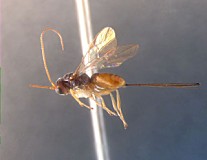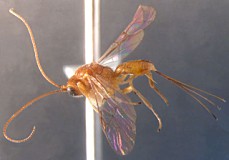Fopius vandenboschi (Fullaway, 1952)
Opius vandenboschi Fullaway, 1952 (new name for javanus Fullaway, preoccupied in Opius by javanus Szepligeti).
Biosteres vandenboschi (Fullaway): Fischer (1971).
This species has previously been placed in both Opius and Biosteres. Biosteres javanus Fullaway, 1920 is a synonym.
There are several color morphs that occur in Southeast Asia, and additional study is needed to determine whether they represent a single, color-variable species or multiple cryptic species.
The influence of various fitness parameters on male mating success was examined by Ramadan et al. (1991) for this and other species that are routinely reared in Hawaii for tephritid biological control. Ramadan et al. (1995) also looked in detail at the reproductive biology of this species. Vargas et al. (2002) published useful studies on comparative demography of this and other species introduced to Hawaii. It was subsequently mass-reared for use in augmentative programs (Ramadan 2004).
A fair amount of additional literature is available on this species.



